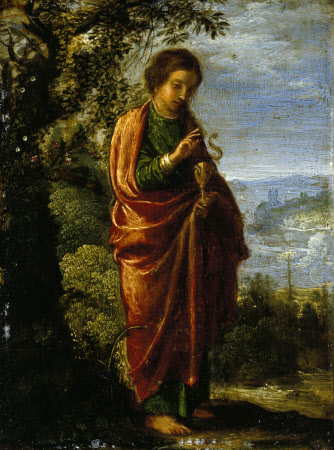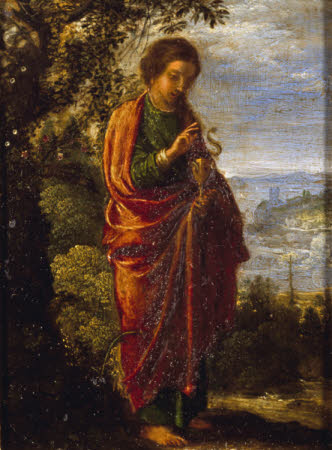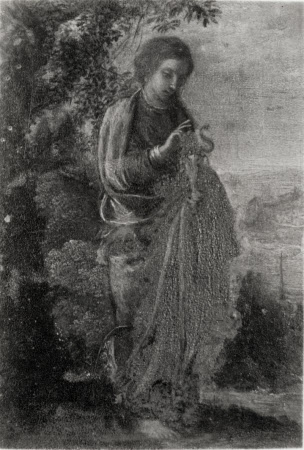Saint John the Evangelist
Adam Elsheimer (Frankfurt am Main 1578 - Rome 1610)
Category
Art / Oil paintings
Date
1605
Materials
Oil on silvered copper
Measurements
90 x 70 mm
Place of origin
Rome
Order this imageCollection
Petworth House and Park, West Sussex
NT 486231
Summary
Oil painting on silvered copper, Saint John the Evangelist by Adam Elsheimer (Frankfurt am Main 1578 – Rome 1610). One of eight small paintings by Adam Elsheimer. Saint John the Evangelist is shown full-length, standing, turned to the right and wearing a green embroidered dress and crimson cloak. He is holding a gold goblet or poisoned chalice as a test of his faith whereby the toxic additive of the snake has neutralised the drink, in his left hand, with a lake and a castle in the background against a cloudy sky.
Full description
These eight little pictures belong amongst the incunabula of English collecting. Although they have been framed separately since the 18th century, they are identifiable with the "Eight Little Pictures in one Frame by Elshammer" at Northumberland House, which were given the high valuation of £250 by Symon Stone in 1671; and before that with the: "Ensen Humor. Eight little pieces" in the posthumous inventory taken of the Duke of Buckingham's collection at York House in 1635 . As at present constituted they do not form a complete or coherent group . A little copper of Saint Lawrence by Elsheimer himself now in the Musée Fabre at Montpellier must once also have belonged to the set, as is demonstrated by a set of copies by Cornelis van Poelenburgh in the Uffizi which further includes an Abraham and Isaac, for which no original is known . Not only does this last again make up an even number, but these ten paintings are in turn made up of natural pairs: the two Saints Johns, Saint Peter and Saint Paul, Abraham and Isaac and Tobias and the Angel, Saint Anne & the Virgin and Saint Joseph & the Christ Child, and Saint Thomas Aquinas and Saint Lawrence. Only this last pairing lacks any obvious compositional or thematic link - which might suggest that the set was originally larger still. A set of copies at one further remove, on a cabinet at Penshurst , might suggest what such other paintings could have been, but also confuses any such attempted reconstruction of the set; for, whilst adding the figures of Saint Francis, Saint Mary Magdalen, and an unidentified Female Saint in a white habit with a staff over her shoulder, it lacks the Abraham and Isaac, and has a Saint Lawrence of a different type. A Saint Francis might well have been paired with the Saint Thomas Aquinas, as representatives of the two great Mendicant Orders, the Franciscans and the Dominicans, but that would have left Saint Lawrence without a counterpart: the obvious one would have been Saint Stephen, the other proto-martyr, but we know of neither original nor copy of this saint by Elsheimer. Nor do the two female saints make an immediately obvious pairing. It is, therefore, perhaps safest to take only the set of Poelenburg copies in the Uffizi as reflections of Elsheimer's originals. The additional saints of the Penshurst cabinet may have been invented to suit its commissioner's special requirements. One thing is immediately conspicuous about Elsheimer's pairs of figures: that they are not in opposition to one another, but face the same direction. This encourages the idea that they were all intended to flank some central image or object, that may not even have been another picture (as is the case with the reconstituted group of pictures of The Story of the Cross, set around The Adoration of the Cross in the Städelsches Kunstinstitut), but might have been a statue, relief, or relic. One could imagine them in tiers of pairs on either side of this. The identities of the saints and patriarchs give no very clear indication as to what this central image or object might have been, nor where it might have been intended for. The fact that there are four images with two figures, and that all of these include a child, might point to an orphanage of infant school ; otherwise the only strong indication of a particular destination for the set is the inclusion of Saint Thomas Aquinas , which would appear to point to a Dominican client (though this argument would be somewhat weakened, if an original of the Saint Francis at Penshurst was really once part of the set). The Saint Thomas Aquinas is also more distinctively characterised than any of the other saints: not only does he stand in front of what looks like the view of an actual church, but he holds a model of one - possibly a simplified reduction of it - in his left hand. A building is sometimes, but not so commonly, found as an attribute of Saint Thomas Aquinas, sometimes balanced upon a book: it apparently denotes his proclamation as a fifth Doctor of the Western Church. He is not often found portrayed on his own, rather than in the company of other Dominican saints, and never before so specific a location. It therefore seems likely that these little copper panels were painted for someone belonging to the religious house in Italy shown in this picture, with which St Thomas Aquinas must have had some particular association; and it may be that the presence of a Saint Lawrence indicates that the dedication of its church was to that saint. At this point, however, speculation fails; none of the places in Italy where Saint Thomas Aquinas taught, or with which he had some special association, ever appears to have borne any resemblance to the church complex shown behind the saint: not Roccasecca, where he was born; not Montecassino, where he was sent as a child with the prospect of becoming abbot; not Anagni, nor Orvieto, nor Viterbo, at all of which he taught; not San Domenico in Naples, where he worked on the Summa Theologica, and the crucifix miraculously addressed him; nor, finally, the Cistercian abbey of Fossanova, where he died, on his way to the Council of Lyons. One amusing detail of Elsheimer's depiction of this saint is that - in conformity with the known facts, but against the grain of the iconographic tradition - he has shown him as decidedly plump. It is possible that the picture is also a disguised portrait of the client, but Elsheimer may also have been asked to make the saint so; it is anyway in keeping with the wonderful humanity that he has given all these normally remote icons. One of the less known of the saint's miracles is that of the divine response to his craving when in Italy for the fresh herrings that he had so adored in Paris! Whatever the originally intended vehicle for this set of copper plates, they seem unlikely ever to have been incorporated into it, to have found their way so soon as separate paintings into the collection of the Duke of Buckingham. On the other hand, the tabernacle with Elsheimer's pictures of the Story and Adoration of the Cross had already left the Grand-Ducal Collections in Florence (for which it had only been acquired by Cosimo II [d.1612] from Juan Perez in 1619 - they may both have been acquisitions of Cosimo II's that Ferdinando II did not retain) by 1635, and its pictures were in England, already broken up, by the end of the century, if not before . More telling is, perhaps, the fact that the set of pictures was already incomplete when in Buckingham's hands. How Buckingham acquired them, we do not know. He had agents all over Europe - but could also have acquired them himself in Spain, when he went there in 1623 with Prince Charles to woo the Infanta for the latter - especially in view of the fact that the first recorded owner of the Tabernacle of the Holy Rood was a Spaniard. But it seems more likely that these little coppers of the Saints and Patriarchs should have followed the Tabernacle of the Holy Rood to Florence, in view not only of the set of copies by Poelenburgh (who was in Italy between 1617 and 1625, at some point working for Cosimo II) in the Grand-Ducal collections in the Uffizi, but also of the fact that the Saint Lawrence appears to have remained in the Grand-Ducal collections until at least 1750 , only to leave them under mysterious circumstances later, to be bequeathed to the city of Montpellier in 1825 by the painter F.-X. Fabre, after his retirement from Florence. The collection of Algernon Percy, 10th Earl of Northumberland (1602-1668) is the only one remaining in Britain of those formed by the members of the court of Charles I, albeit depleted, and now divided between the houses of the two successive branches of the family, the Earls of Egremont and the Dukes of Northumberland. Much of it was assembled in the troubled times of the Civil War and Commonwealth, when, as one of the few magnates on the Parliamentary side, he was in a position to acquire, when most of his peers were being forced to sell . In the case of these Elsheimers, they were the greatest prize that he obtained as the tenant of the widowed Duchess of Buckingham at York House, from 1640 to 1647. Parliament ordered the sale of the pictures there, now the 2nd Duke's, as the property of a delinquent. By masterly inactivity and timely negotiation, he prevented either their sale or their destruction as superstitious images, so that the Duke was ultimately able to ship sixteen chests of pictures to the Low Countries from the sale of which he was able to finance his part in the Royalist cause . But, in the process, Northumberland had indicated to Parliament that he was prepared to accept "some of the smaller pictures in consideration of that money" that Parliament still owed him for his earlier services to its cause; it appears to have been in this way that he obtained the little pictures by Elsheimer, but also some not so small, such as Titian's portrait of Cardinal Georges d'Armagnac and his Secretary Guillaume Philandrier (Northumberland Collection) and two pictures of the Madonna and Child with St John the Baptist by Andrea del Sarto (Egremont Collection). Originally divided almost equally between Northumberland (formerly Suffolk) House in London and Petworth, with many fewer at Syon House, but with most of the better originals in London, Northumberland's collections passed by the marriage of his grand-daughter, the last Percy heiress, to the 6th Duke of Somerset. On the failure of his son to have a male heir, they were divided between the son of the 6th Duke's son-in-law, by special remainder 2nd Earl of Egremont, and the 7th Duke's son-in-law, Sir Hugh Smithson, who took the old Northumberland name of Percy and became Earl (subsequently created Duke) of Northumberland by a similar remainder. The division of the collections that then took place seems to have been entirely contingent upon which house they were in at the time; so it was that most of the Titians (including The Vendramin Family now in the National Gallery) passed to the new Earl (later Duke) of Northumberland, whereas these little Elsheimers passed to the 2nd Earl of Egremont (himself a great collector), and thus descended with Petworth. Notes: (i) Jeremy Wood, 'Van Dyck and the Earl of Northumberland: Taste and Collecting in Stuart England', in Van Dyck 350, ed. Susan J. Barnes & Arthur K. Wheelock Jr., National Gallery of Art, Washington, 1994, p.305, no. [40]. (ii) Randall Davies, 'An inventory of the Duke of Buckingham's Pictures, etc., at York House in 1635', The Burlington Magazine, vol.X (1907), p.382. (iii) For the fullest discussion of the whole group, copies of individual pictures, & c., see Keith Andrews, Adam Elseheimer, 1977, cat. 17, pp.147 -48, pls. 55 -63 & col. pl.IV; translated and revised edn., Munich, 1985, pp.182 -83, col. pls. 67 -75. (iv) Catalogue des Peintres et Sculptures exposées dans les galeries du Musée Fabre de la Ville de Montpellier, 2nd edn., 1914, p.232, no.835 (indicated as part of Fabre's original donation of his works of art and library in Florence to the commune of Montpellier in 1825). (v) Gli Uffizi:Catalogo Generale, Florence, 1979, pp.417 -418, nos. P1203 & 1204; Eckhard Schaar, 'Poelenburgh und Breenbergh in Italian, und ein Bild Elsheimers', Mitteilungen des Kunsthistorischen Institutes in Florenz, vol.IX/1 (August 1959), pp.34 -35. (vi) It is also interesting, but inconclusive, that Elsheimer should have made one of his rare etchings of just the (vii) Saint Joseph & Christ Child (Hollstein, VI.147, no.8; Andrews, op.cit., cat.57). Previously called Saint Dominic, but right reidentified by Andrews: the star on his breast and the model church are regular attributes of St Thomas Aquinas, the quill pen takes the place of the usual book, but obviously refers, as that does, to his writings. (viii) For the reconstruction of this tabernacle, see Andrews,1977, no.16. The suggestion that it was in the collection of the Earl of Arundel is, however, devoid of any foundation; something of it could hardly have escaped being engraved by Hollar - like the present set of saints when they were in Northumberland's collection - if it had been. The earliest recorded provenance of its constituent pictures also suggests otherwise: the Adoration of the Cross may have turned up in the collection of the collection of the Duke of Norfolk in this century, but the four little square copper plates of The Story of the Cross are first recorded in an inventory of the collection of the Hon. Andrew Newport, later Lord Torrington, of between 1696 and 1715, along with the Realm of Venus and the Realm of Minerva, and The Stoning of St Stephen (Bradford Archives, Weston Park; I am most grateful to Mr. Keith Verrall for giving me a photocopy of this). (ix) See Schaar, 1959, pp.26 -28 & 40 n.50. (x) It is recorded in the 1704 inventory of the Uffizi, and by C-N Cochin in his Voyage d'Italie [of 1749-51], 1769, vol.II, p.9: "Un autre petit tableau représentant un diacre, par Adam Helsemer; cette figure est très spirituellement touchée, le visage est un peu de couleur semblable à celle de la faïnce". (xi) For excellent and thorough documentation of Northumberland's collecting and collections, see Jeremy Wood, 1994, to which should be added Wood's and Christopher Brown's articles in The Burlington Magazine, vol. CXXXXII, October, 1990, pp. 704-10, on Van Dyck's collections and their dispersal, for what Northumberland obtained from these and how. (xii) John Stoye, English Travellers Abroad 1604—1667, revised edn., New Haven & London, 1989, pp.215 - 30. (adapted from author's version/pre-publication, Alastair Laing, In Trust for the Nation, exh. cat., 1995)
Provenance
First recorded, as: "Ensen Hamor - Eight little pieces", in the posthumous inventory taken of George, 1st Duke of Buckingham's (1592 - 1628) pictures, &c., at York House in 1635; then as: "Eight little Pictures in one Frame by Elshammer" valued at £250, in Symon Stone's posthumous inventory of Joscelyn, 11th Earl of Northumberland's (1644 -1670) pictures at Northumberland House, 30 June 1671, [No.40]; passed by the marriage in 1682 of his granddaughter, Lady Elizabeth, the last Percy heiress, to Charles, 6th Duke of Somerset (1662 - 1748); Algernon, 7th Duke of Somerst (1684 - 1750); thence to his nephew, Charles, 2nd Earl of Egremont (1710 - 1773), on the division of the collection between him and the 7th Duke's son-in-law, Sir Hugh Smithson, later 1st Duke of Northumberland ( 1714 - 76); listed in 'My Lady's Dressing Room', in Egremont House, Piccadilly, in his posthumous inventory of 5-10 Dec 1764; thence by descent at Petworth until in 1952 of the 3rd Lord Leconfield, who had given Petworth to the NationalTrust in 1947, and whose nephew and heir, John Wyndham, 6th Lord Leconfield and ist Lord Egremont (1920 - 1972), arranged for the acceptance by HM Treasury of a major part of the collections in lieu of death-duties in 1956
Credit line
Petworth House, The Egremont Collection (National Trust)
Makers and roles
Adam Elsheimer (Frankfurt am Main 1578 - Rome 1610), artist
Exhibition history
In Trust for the Nation, National Gallery, London, 1995 - 1996, no.59a
References
Waddingham 1972 Malcolm Waddingham, 'Elsheimer revisited', The Burlington Magazine, vol.CXIV, Sept. 1972, pp.605—6 , figs. 17 & 18 Weizsäcker, 1936: Heinrich Weizsäcker, Adam Elsheimer, der Maler von Frankfurt, Berlin, 1936, vol.I, p.112-14 cat.nos39 A-H Andrews 1985 Keith Andrews, Adam Elsheimer, Oxford, 1977, revised 1985, cat. nos. 17A-17H, pp.182-3 & col.pls. 67-74 Gore 1989 St John Gore, 'The Background to the Inventories recording the Acquisitions of the 10th Earl of Northumberland and of the 2nd Earl of Egremont', in The Fashioning and Functioning of the British Country House, ed.G. Jackson-Stops, 1989, pp.121-31, p. 124, fig. 4 Barnes and Wheelock, 1994: Susan J. Barnes and Arthur K. Wheelock Jr ed. Van Dyck 350, Washington, 1994, pp.283, 305, no. 40 and 316 n. 16 Remastered - Bosch to Bellotto: An Exhibition of Petworth's European Old Masters (exh cat) (Andrew Loukes) Petworth House, West Sussex, 9 January - 6 March 2016, cat.9



